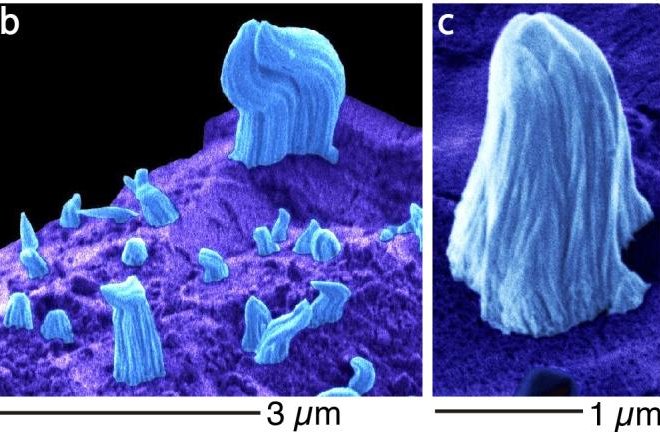
Scientists discovered tiny hair-like iron crystals on dust particles from Itokawa asteroid samples. Photo by Friedrich-Schiller University of Jena
Feb. 28 (UPI) -- Scientists have found iron "whiskers" on particles from the asteroid samples returned by the Japanese space agency's Hayabusa mission.
In 2005, JAXA's Hayabusa probe hunted down and landed on the near-Earth asteroid 25143 Itokawa. Five years later, the spacecraft returned to Earth with soil samples collected from the asteroid's surface -- something that had never been done before.
Over the last decade, the Itokawa samples have been analyzed by dozens of scientists, but until recently, the presence of these tiny crystalline threads of iron went unnoticed.
The iron whiskers were first spotted by Japanese researcher Toru Matsumoto, currently a visiting scientist with the Institute of Geosciences at the Friedrich-Schiller University of Jena in Germany.
Matsumoto identified the hair-like iron crystals after capturing high-resolution images of Itokawa dust particles using a transmission electron microscope. Scientists have since located the same whiskers around particles from other Itokawa samples.
The whiskers have provided scientists with clues as to how Itokawa first formed.
"These structures are the consequence of cosmic influences on the surface of the asteroid," Falko Langenhorst, researcher with the Institute of Geosciences, said in a news release.
Itokawa is rich in the mineral troilite, which contains both iron and sulphur. The mineral is regularly bombarded with high-energy particles from solar wind.
"As a result of space weathering, the iron is released from the troilite and deposited on the surface in the form of the needles that have now been discovered," said Langenhorst.
Scientists detailed their analysis of the newly discovered asteroid whiskers this week in the journal Nature Communications. Their findings have laid the groundwork for how scientists can use evidence of space weathering to illuminate the history of celestial bodies.
In the years ahead, scientists will have a number of asteroid samples to test, including samples returned by NASA's OSIRIS-REx probe, which is poised to scoop samples from the surface of the asteroid Bennu, as well as JAXA's Hayabusa2, which is already on its way back to Earth, with samples from the near-Earth asteroid 162173 Ryugu in tow.
No comments:
Post a Comment